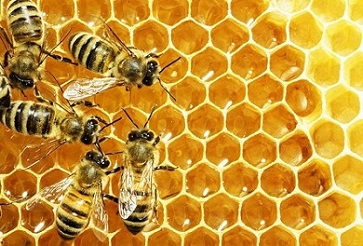BREAKING! Italian Scientists Find SARS-CoV-2 In Honey Bees And Honey Collected In Apiaries Across The Campania Region!
Nikhil Prasad Fact checked by:Thailand Medical News Team May 07, 2024 11 months, 2 weeks, 4 days, 19 hours, 17 minutes ago
COVID-19 News:
Honey Bees as Bioindicators of Airborne Pathogens.
The world has been grappling with the challenges posed by the COVID-19 pandemic since its emergence, with scientists and researchers constantly seeking innovative ways to monitor, detect, and combat the spread of the virus. In a groundbreaking development, Italian scientists from the Department of Food Security Coordination, Istituto Zooprofilattico Sperimentale del Mezzogiorno-Italy, University of Naples Federico II-Italy, and Istituto Superiore di Sanità, Viale Regina Elena-Italy have uncovered a fascinating correlation between honey bees and the prevalence of SARS-CoV-2, the virus responsible for COVID-19. Their findings covered in this
COVID-19 News report, shed light on the potential of honey bees as bioindicators of airborne pathogens.
 Scientists Find SARS-CoV-2 In Honey Bees And Honey
Understanding Airborne Transmission and Bioindicators
Scientists Find SARS-CoV-2 In Honey Bees And Honey
Understanding Airborne Transmission and Bioindicators
The primary mode of transmission of SARS-CoV-2 among humans is through aerosols, which are tiny airborne particles containing the virus. These aerosols, generated through activities like coughing and sneezing, can settle on surfaces and fomites, creating potential routes for infection. Additionally, particulate matter (PM) suspended in the air, comprising natural and human-origin particles, can also carry the virus. This intricate interplay between airborne pathogens and environmental elements has prompted researchers to explore unconventional avenues for monitoring and surveillance.
Honey bees, renowned for their role as bioindicators of environmental pollutants, exhibit a unique capacity to collect diverse substances during their foraging expeditions. Their intricate interactions with the environment, coupled with their ability to capture particulate matter, make them intriguing subjects for studying the prevalence of airborne pathogens like SARS-CoV-2.
The Study: Unveiling the Presence of SARS-CoV-2 in Honey Bees and Honey
The study conducted by Italian scientists aimed to evaluate the potential of honey bees as bioindicators of SARS-CoV-2 prevalence. Over a period spanning from September 2020 to June 2022, a total of 91 honey bee samples and 6 honey samples were collected from various apiaries across the Campania region in Southern Italy. These samples were meticulously analyzed using Droplet Digital RT-PCR targeting specific SARS-CoV-2 genes (Orf1b and N).
The findings were striking, with 12 out of 91 honey bee samples and 2 out of 6 honey samples testing positive for SARS-CoV-2. This revelation not only underscores the potential of honey bees as indicators of airborne pathogens but also hints at their utility in detecting outbreaks and monitoring environmental health.
Analyzing the Results and Implications
Delving deeper into the results, a temporal pattern emerged. No honey bee samples tested positive during the initial period (T1: September 2020–December 2020), correspon
ding to the early stages of the pandemic marked by stringent containment measures. However, as restrictions eased and human movement increased in subsequent periods (T2-T4), the prevalence of SARS-CoV-2 in honey bee samples showed a corresponding rise.
This temporal correlation with human epidemiological data highlights the interconnectedness between human activity, viral circulation, and honey bee interactions. It's essential to note that none of the individuals involved in sample collection or beekeeping were infected with SARS-CoV-2 during the sampling periods, ruling out direct contamination from humans.
Technical Advances and Methodology
A key aspect of the study was the utilization of Droplet Digital PCR (dd-PCR) for robust virus detection and quantification. Compared to traditional RT-PCR methods, dd-PCR offers enhanced sensitivity and accuracy, making it a valuable tool for detecting low viral loads and minimizing false-negative results.
Moreover, the analysis of honey samples for SARS-CoV-2 RNA highlighted the virus's potential presence in hive products. However, this does not imply a direct transmission route through honey consumption, as environmental factors such as sunlight exposure and drying processes can influence viral integrity and infectivity.
Limitations and Future Directions
While the study presents promising insights, it's crucial to acknowledge its limitations and avenues for further research. The detection of SARS-CoV-2 RNA in honey bees and honey does not confirm infectivity, emphasizing the need for comprehensive virological studies to assess viral viability and transmission pathways.
Additionally, the study's geographical scope focused on the Campania region, necessitating broader investigations across diverse terrains to validate the findings. Collaborative efforts involving multidisciplinary teams encompassing virologists, entomologists, and environmental scientists could amplify the impact of bee-based monitoring strategies.
Potential Applications and Conclusion
The implications of this research extend beyond SARS-CoV-2 monitoring. Honey bees could serve as sentinel organisms for detecting a spectrum of airborne pathogens, aiding in early warning systems and public health interventions. Integrating bee-based monitoring networks with existing environmental monitoring infrastructure could enhance surveillance capabilities and provide comprehensive insights into ecosystem health.
In conclusion, the study underscores the remarkable potential of honey bees as bioindicators in the era of emerging infectious diseases. While further studies are warranted to validate and expand upon these findings, the synergy between nature's pollinators and scientific innovation offers a compelling avenue for proactive disease surveillance and mitigation strategies.
The study findings were published in the peer reviewed journal: Viruses.
https://www.mdpi.com/1999-4915/16/5/729
For the latest
COVID-19 News, keep on logging to Thailand Medical News.
